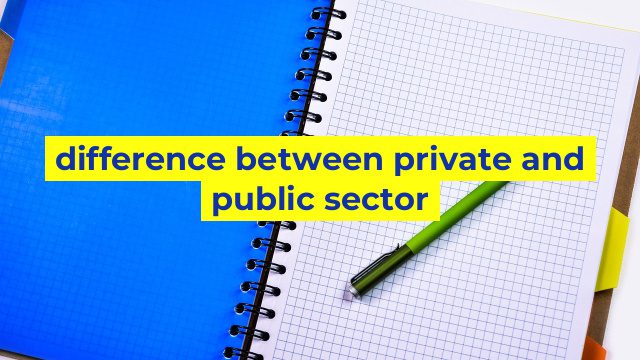The Key Differences Between Private and Public Sectors Explained
Introduction
When it comes to employment, the most popular sectors are the private and public sectors. Both types of sectors offer stable employment and opportunities for growth. However, there are some significant differences between the private and public sectors that must be noted.
Ownership
The private sector is owned and operated by private individuals or corporations. They operate their businesses to make a profit, and the owners are accountable for the business decisions. The public sector, on the other hand, is owned and managed by the government agencies. The primary goal of the public sector is to provide services to the people and promote social welfare, regardless of profitability.
Objectives
The objectives of the private and public sectors are different. The private sector is profit-oriented, and the primary objective is to make a profit by providing goods and services to the consumers. The public sector, on the other hand, is not profit-oriented. The primary objective is to provide services to the people at an affordable cost, and the government monitors the activities closely.
Size
The size of the private sector depends on the number of companies in the industry. The size of the public sector is determined by the number of government agencies and institutions. The public sector is responsible for providing social services to the people, and the size of the sector depends on the population and the needs of the community.
Competition
The private sector operates in a highly competitive market. The competition among the companies pushes them to innovate and improve the quality of their goods and services. The public sector, on the other hand, may not face the same level of competition as the private sector. However, government agencies do compete for funding and resources.
Salary
The salaries in the private sector are usually higher than in the public sector. A significant factor behind this difference is the level of competition between companies for skilled workers. In contrast, in the public sector, the prime consideration is not profitability or productivity, but rather social service delivery.
Conclusion
In conclusion, the private and public sectors differ in several ways, including ownership, objectives, size, competition, and salary. Understanding these differences is essential for individuals considering which sector to join. One must weigh the advantages and disadvantages of both sectors to make an informed career choice.
Table difference between private and public sector
| Aspect | Private Sector | Public Sector |
|---|---|---|
| Ownership | Owned by individuals or groups of investors | Owned and operated by the government |
| Profit motive | Goal is to generate profit for owners/investors | Goal is to provide essential services or to benefit society |
| Competition | Competitive market environment with other private companies | May or may not face competition, but often has a monopoly or oligopoly in certain areas |
| Efficiency | Often driven by market competition and profit motive, which can lead to more efficient operations | May face less pressure to be efficient due to lack of competition, bureaucratic processes, and sometimes restrictive regulations |
| Flexibility | Can adapt quickly to changing market conditions and consumer demands | May be slower to adapt due to the bureaucratic processes and regulations |
| Accountability | Accountable primarily to shareholders and investors | Accountable to the government and public at large |
| Innovation | May have greater incentive for innovation due to the potential for profit and competition | May have less incentive for innovation due to budget constraints and bureaucratic processes |


